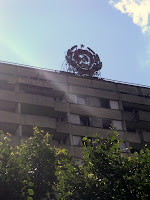 Pripyat is just a few miles from the reactor site, in an inner zone cut off by yet a further checkpoint.
Pripyat is just a few miles from the reactor site, in an inner zone cut off by yet a further checkpoint.
‘38,000 people lived here’, Iryna told us, ‘it was built as a new town for the workers at the reactor. In the afternoon after the explosion, a thousand coaches came here. People were told to take just a few things they needed, they were being evacuated for only three days, then they would return. They were never returned. Some of them were settled in Kyiv, some in Moscow, some in Minsk, all different towns of the Soviet Union. Now of course these are all different countries, we don’t have records of what happened to them all eventually.
‘Now it is illegal to live here, or anywhere in the exclusion zone. The city is empty. We will drive along what was Lenin Prospekt – you know all towns had Lenin Prospekt as their main street in those days - to the central square. You will get out to look around. Do not go into any of the buildings, they are unsafe. Do not walk on the grass, it is unsafe, keep to the pavements and the roadways. Do not go far from the coach. You will have only fifteen minutes.’

We drove down the Prospekt, which was slowly turning into a temperate jungle,shrubs, trees and grass invading the roadway, the pavements, the blocks of flats. On some of the roofs were still to be seen hammer-and-sickle signs, the last left in Ukraine, too dangerous to demount.
‘So there is really no-one here?’ came the question.

Iryna paused. ‘It is against the law for anyone to live here. Still, some people came back. They were born here, they didn’t want to live anywhere else. They came in illegally. They lived off the berries and the mushrooms in the woods. Although it was forbidden. Now eventually the government decided they were here anyway, they allow in some supplies for them, food, medical supplies, some social help. They are all elderly now, pensioners. But actually it is forbidden.’
When we reached the square we found another small bus there, with its tourist passengers huddled around it taking photos. ‘Actually it is not allowed to have more than one bus in one place, so we will take you to another part of the town.’ Thus we were fortunate to visit a far less frequented corner of the dead city, ulitsa Kosygin.

There followed a dreamlike and profoundly disturbing few minutes as we wandered up and down the road, venturing into some of the side streets – taking photographs of –what? Absences? Empty windows, children’s toys still lying in the undergrowth, a lush greenery we knew to be contaminated by radioactivity……
This was the catastrophe I had grown up through the ‘50s to the ‘80s fearing, along with all my contemporaries, the world when the Cold War had grown hot, human constructs without any humans after an atomic holocaust. Now here was a snapshot, secretly cordoned away in the Ukrainian countryside, that preserved that horrid, familiar nightmare……….


your conspicous coding on the blog kind of spooked me - it kept repeating
ReplyDelete...supportEmptyParas...endif...
did you deliberatly add the coding for effect or was it caused by the radiation?
An unintentional effect I assure you - something to do with copying text from Word - anyway hope it's now fixed - or maybe the radiaton has just ebbed away......
ReplyDelete